1, Background of the topic
Mobile phone itself is not a standard, so there will eventually be products with different thickness, and thickness has become an important parameter in mobile phone products. It is this parameter that various manufacturers rack their brains in order to reduce the cost. First of all, from the perspective of marketing and positioning, mobile phones are thinner than people. The two decimal places after the decimal point may be a key point to seize the first mind of users. Now that information is so explosive, the first mind is extremely important. Use the crawler tool to crawl the thickness ranking data of the mobile phone, and then visually output the analysis results.
2, Thematic web crawler design
1. Name of themed web crawler: crawling mobile phone thickness ranking
2. Content and data feature analysis of topic web crawler
Climb the mobile phone thickness ranking, and select the ranking, name and thickness for data analysis
3. Overview of thematic web crawler design scheme (including implementation ideas and technical difficulties)
Implementation idea: import the required library, obtain the interface, analyze the data, save the data to the csv file, and then visually analyze the data according to the crawled data.
Technical difficulties: find and import relevant Libraries
3, Analysis on the structural characteristics of theme pages
Crawl website: Mobile phone thickness ranking - fast technology ladder list (kkj.cn)
1. Structure and feature analysis of theme page
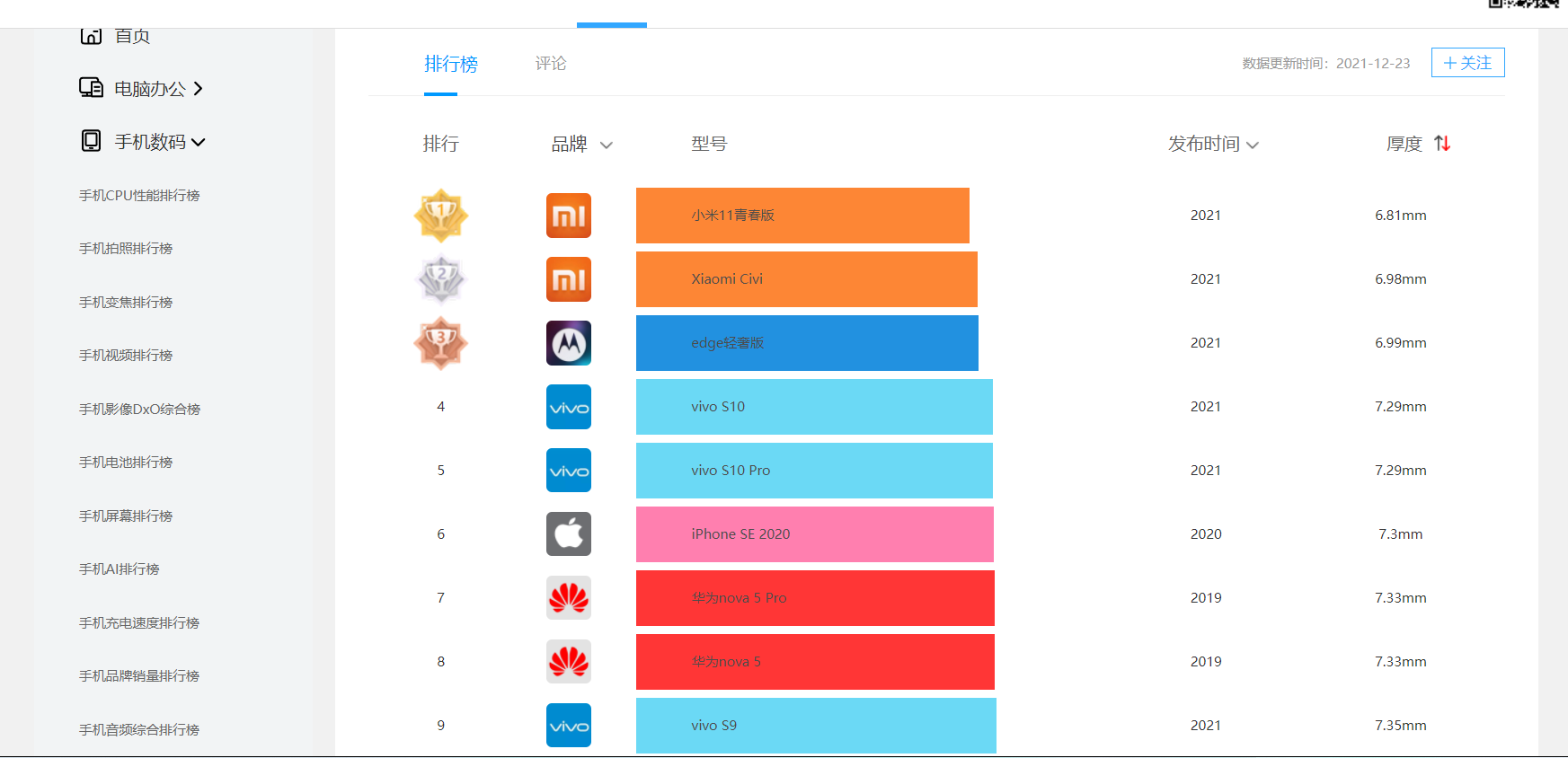
2. HTML page parsing

4, Web crawler programming
1. Data crawling and acquisition
1 #-*- coding = utf-8 -*- 2 from bs4 import BeautifulSoup 3 #Perform web page parsing 4 5 import re 6 #Text matching 7 8 import urllib.request,urllib.error 9 #formulate URL,Get web page data 10 11 import xlwt 12 #conduct excel operation 13 14 import sqlite3 15 #conduct SQLite Database operation 16 17 18 def getData(url): 19 datalist = [] 20 html = askURL(url) 21 soup = BeautifulSoup(html,"html.parser") 22 i=1 23 for item in soup.find_all('tr', class_="list_tr"): 24 data = [] 25 item = str(item) 26 27 pm = i 28 i=i+1 29 data.append(pm) 30 31 findbt = re.compile(r'href="javascript:;".*>(.*?)</a>') 32 bt = re.findall(findbt, item)[0] 33 data.append(bt) 34 findrs = re.compile(r'class="mark1">(.*?)</li>') 35 rs = re.findall(findrs, item)[0].replace("mm","") 36 data.append(rs) 37 datalist.append(data) 38 if i==31: 39 break 40 return datalist 41 42 43 def askURL(url): 44 head = { 45 "User-Agent": "Mozilla / 5.0 (Windows NT 10.0; Win64; x64) AppleWebKit/537.36(KHTML, like Gecko) Chrome / 96.0.4664.110 Safari / 537.36" 46 } 47 request = urllib.request.Request(url, headers=head) 48 html = "" 49 try: 50 response = urllib.request.urlopen(request) 51 html = response.read().decode("utf-8") 52 except urllib.error.URLError as e: 53 if hasattr(e, "code"): 54 print(e.code) 55 56 if hasattr(e, "reason"): 57 print(e.reason) 58 59 return html 60 61 url = "https://rank.kkj.cn/Phone63.shtml" 62 getData(url) 63 print("Climb over!") 64 65 66 67 url = ("https://rank.kkj.cn/Phone63.shtml") 68 html=askURL(url) 69 datalist = getData(url) 70 print(datalist) 71 print("Climb over!") 72 savepath = ".\\Mobile phone thickness ranking.xls" 73 book = xlwt.Workbook(encoding="utf-8",style_compression=0) 74 #establish workbook object 75 sheet = book.add_sheet('Mobile phone thickness ranking',cell_overwrite_ok=True) 76 77 #Create worksheet 78 col = ("ranking","Phone name","Mobile phone thickness") 79 80 for i in range(0,3): 81 sheet.write(0,i,col[i]) #Listing 82 83 for i in range(0,30): 84 85 #test print("The first%d strip" %(i+1)) 86 87 data = datalist[i] 88 for j in range(0,3): 89 sheet.write(i+1,j,data[j]) 90 #data 91 92 book.save(savepath) 93 94 print('Exported table!')


2. Clean and process the data
Import data
1 #Import data 2 import pandas as pd 3 import numpy as np 4 import seaborn as sns 5 import sklearn 6 #Import data 7 ranking=pd.DataFrame(pd.read_excel(r'C:\Users\liuquanwang\Desktop\Mobile phone thickness ranking.xls')) 8 #Display the first five rows of data 9 ranking.head()
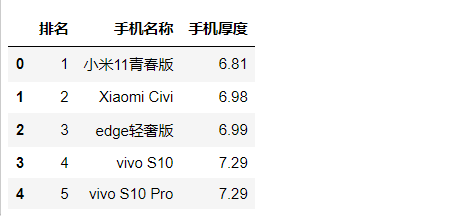
Find duplicate values
1 # find duplicate values2 ranking duplicated()

Delete duplicate values
1 #Delete duplicate values 2 ranking=ranking.drop_duplicates() 3 #First five lines of output data 4 ranking.head()

Outlier query
1 # outlier query 2 ranking describe()
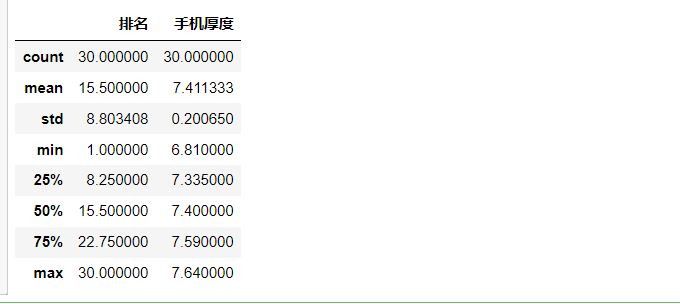
3. Text analysis (optional): jieba word segmentation, wordcloud visualization
4. Data analysis and visualization
#Histogram import matplotlib.pyplot as plt import pandas as pd import numpy as np df=pd.read_excel(r'C:\Users\liuquanwang\Desktop\Mobile phone thickness ranking.xls') index=np.array(df['ranking']) #Indexes data=np.array(df['Mobile phone thickness']) #Used to display Chinese labels normally plt.rcParams['font.sans-serif']=['Arial Unicode MS'] #Used to display negative signs normally plt.rcParams['axes.unicode_minus']=False #modify x Axis font size is 12 plt.xticks(fontsize=12) #modify y Axis font size is 12 plt.yticks(fontsize=12) print(data) print(index) #x label plt.xlabel('ranking') #y label plt.ylabel('Mobile phone thickness') s = pd.Series(data, index) s.plot(kind='bar',color='g') plt.grid() plt.show()
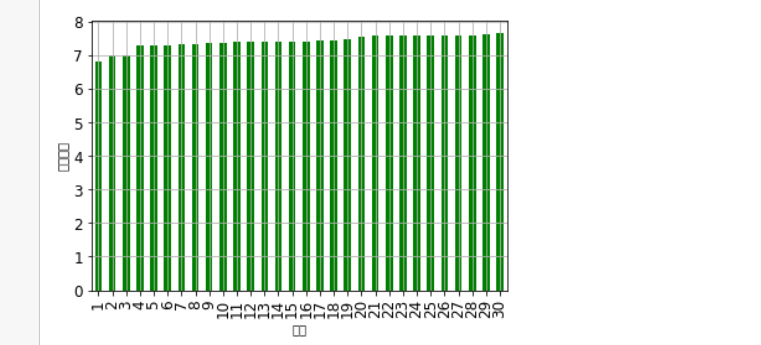
1 #Scatter chart, line chart 2 kuake_df=pd.read_excel(r'C:\Users\liuquanwang\Desktop\Mobile phone thickness ranking.xls') 3 plt.rcParams['font.sans-serif']=['Arial Unicode MS'] 4 plt.rcParams['axes.unicode_minus']=False 5 plt.xticks(fontsize=12) 6 plt.yticks(fontsize=12) 7 #Scatter 8 plt.scatter(kuake_df.ranking, kuake_df.Mobile phone thickness,color='b') 9 #broken line 10 plt.plot(kuake_df.ranking, kuake_df.Mobile phone thickness,color='r') 11 #x label 12 plt.xlabel('ranking') 13 #y label 14 plt.ylabel('Mobile phone thickness') 15 plt.show()
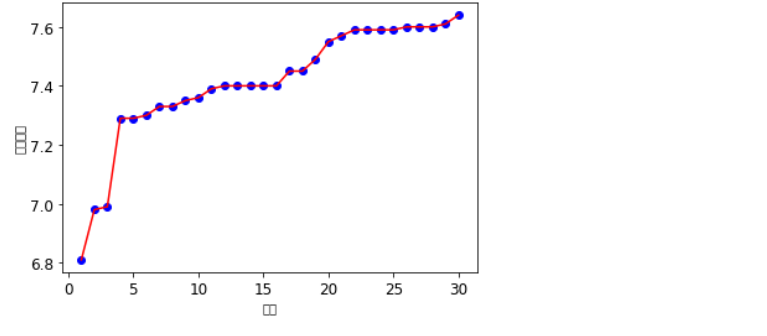
1 # Fan chart bar chart 2 import matplotlib.pyplot as plt 3 plt.rcParams['font.sans-serif']=['SimHei'] #Display Chinese 4 plt.rcParams['axes.unicode_minus']=False 5 Type = ['6.50~7.00', '7.00~7.50', '7.50~8.00'] 6 Data = [3, 16,11] 7 plt.pie(Data ,labels=Type, autopct='%1.1f%%') 8 plt.axis('equal') 9 plt.title('Proportion of mobile phone thickness range') 10 plt.show() 11 plt.bar(['6.50~7.00', '7.00~7.50', '7.50~8.00'], 12 [3, 16,11], 13 label="Proportion of mobile phone thickness range") 14 plt.legend() 15 plt.show()
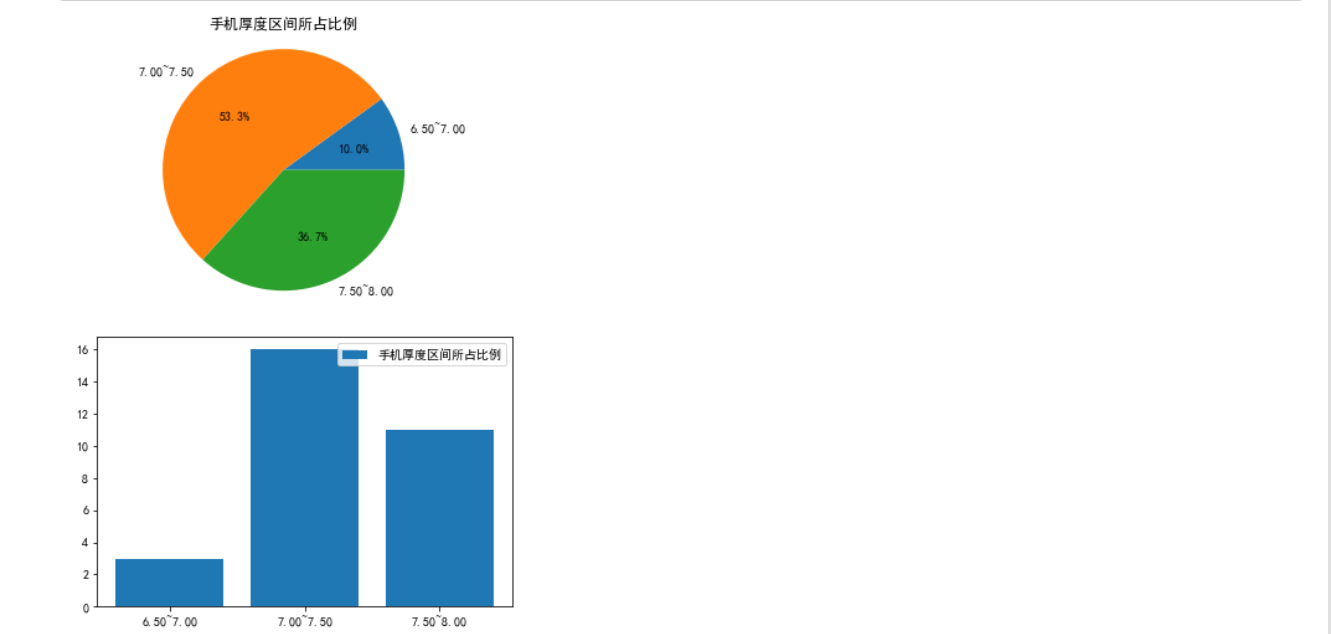
5. According to the relationship between the data, analyze the correlation coefficient between the two variables, draw the scatter diagram, and establish the regression equation (univariate or multivariate) between the variables
1 import scipy.optimize as opt 2 import matplotlib.pyplot as plt 3 import matplotlib 4 x0=np.array(df['ranking']) 5 y0=np.array(df['Mobile phone thickness']) 6 def func(x,c0): 7 a,b,c=c0 8 return a*x**2+b*x+c 9 def errfc(c0,x,y): 10 return y-func(x,c0) 11 c0=[0,2,3] 12 c1=opt.leastsq(errfc,c0,args=(x0,y0))[0] 13 a,b,c=c1 14 print(f"The fitting equation is: y={a}*x**2+{b}*x+{c}") 15 chinese=matplotlib.font_manager.FontProperties(fname='C:\Windows\Fonts\simsun.ttc') 16 plt.plot(x0,y0,"ob",label="sample data ") 17 plt.plot(x0,func(x0,c1),"r",label="Fitting curve") 18 #x label 19 plt.xlabel("ranking") 20 #y label 21 plt.ylabel("Mobile phone thickness") 22 plt.legend(loc=3,prop=chinese) 23 plt.show()

6. Data persistence
Save data for next use.
7. Summary
1 #-*- coding = utf-8 -*- 2 from bs4 import BeautifulSoup 3 #Perform web page parsing 4 5 import re 6 #Text matching 7 8 import urllib.request,urllib.error 9 #formulate URL,Get web page data 10 11 import xlwt 12 #conduct excel operation 13 14 import sqlite3 15 #conduct SQLite Database operation 16 17 18 def getData(url): 19 datalist = [] 20 html = askURL(url) 21 soup = BeautifulSoup(html,"html.parser") 22 i=1 23 for item in soup.find_all('tr', class_="list_tr"): 24 data = [] 25 item = str(item) 26 27 pm = i 28 i=i+1 29 data.append(pm) 30 31 findbt = re.compile(r'href="javascript:;".*>(.*?)</a>') 32 bt = re.findall(findbt, item)[0] 33 data.append(bt) 34 findrs = re.compile(r'class="mark1">(.*?)</li>') 35 rs = re.findall(findrs, item)[0].replace("mm","") 36 data.append(rs) 37 datalist.append(data) 38 if i==31: 39 break 40 return datalist 41 42 43 def askURL(url): 44 head = { 45 "User-Agent": "Mozilla / 5.0 (Windows NT 10.0; Win64; x64) AppleWebKit/537.36(KHTML, like Gecko) Chrome / 96.0.4664.110 Safari / 537.36" 46 } 47 request = urllib.request.Request(url, headers=head) 48 html = "" 49 try: 50 response = urllib.request.urlopen(request) 51 html = response.read().decode("utf-8") 52 except urllib.error.URLError as e: 53 if hasattr(e, "code"): 54 print(e.code) 55 56 if hasattr(e, "reason"): 57 print(e.reason) 58 59 return html 60 61 url = "https://rank.kkj.cn/Phone63.shtml" 62 getData(url) 63 print("Climb over!") 64 65 66 67 url = ("https://rank.kkj.cn/Phone63.shtml") 68 html=askURL(url) 69 datalist = getData(url) 70 print(datalist) 71 print("Climb over!") 72 savepath = ".\\Mobile phone thickness ranking.xls" 73 book = xlwt.Workbook(encoding="utf-8",style_compression=0) 74 #establish workbook object 75 sheet = book.add_sheet('Mobile phone thickness ranking',cell_overwrite_ok=True) 76 77 #Create worksheet 78 col = ("ranking","Phone name","Mobile phone thickness") 79 80 for i in range(0,3): 81 sheet.write(0,i,col[i]) #Listing 82 83 for i in range(0,30): 84 85 #test print("The first%d strip" %(i+1)) 86 87 data = datalist[i] 88 for j in range(0,3): 89 sheet.write(i+1,j,data[j]) 90 #data 91 92 book.save(savepath) 93 94 print('Exported table!') 95 96 #Data cleaning 97 import pandas as pd 98 import numpy as np 99 import seaborn as sns 100 import sklearn 101 #Import data 102 ranking=pd.DataFrame(pd.read_excel(r'C:\Users\liuquanwang\Desktop\Mobile phone thickness ranking.xls')) 103 #Display the first five rows of data 104 ranking.head() 105 106 #Find duplicate values 107 ranking.duplicated() 108 109 #Delete duplicate values 110 ranking=ranking.drop_duplicates() 111 #First five lines of output data 112 ranking.head() 113 114 #Outlier query 115 ranking.describe() 116 117 #Histogram 118 import matplotlib.pyplot as plt 119 import pandas as pd 120 import numpy as np 121 df=pd.read_excel(r'C:\Users\liuquanwang\Desktop\Mobile phone thickness ranking.xls') 122 index=np.array(df['ranking']) 123 #Indexes 124 data=np.array(df['Mobile phone thickness']) 125 #Used to display Chinese labels normally 126 plt.rcParams['font.sans-serif']=['Arial Unicode MS'] 127 #Used to display negative signs normally 128 plt.rcParams['axes.unicode_minus']=False 129 #modify x Axis font size is 12 130 plt.xticks(fontsize=12) 131 #modify y Axis font size is 12 132 plt.yticks(fontsize=12) 133 print(data) 134 print(index) 135 #x label 136 plt.xlabel('ranking') 137 #y label 138 plt.ylabel('Mobile phone thickness') 139 s = pd.Series(data, index) 140 s.plot(kind='bar',color='g') 141 plt.grid() 142 plt.show() 143 144 #Scatter chart, line chart 145 kuake_df=pd.read_excel(r'C:\Users\liuquanwang\Desktop\Mobile phone thickness ranking.xls') 146 plt.rcParams['font.sans-serif']=['Arial Unicode MS'] 147 plt.rcParams['axes.unicode_minus']=False 148 plt.xticks(fontsize=12) 149 plt.yticks(fontsize=12) 150 #Scatter 151 plt.scatter(kuake_df.ranking, kuake_df.Mobile phone thickness,color='b') 152 #broken line 153 plt.plot(kuake_df.ranking, kuake_df.Mobile phone thickness,color='r') 154 #x label 155 plt.xlabel('ranking') 156 #y label 157 plt.ylabel('Mobile phone thickness') 158 plt.show() 159 160 # Fan chart bar chart 161 import matplotlib.pyplot as plt 162 plt.rcParams['font.sans-serif']=['SimHei'] #Display Chinese 163 plt.rcParams['axes.unicode_minus']=False 164 Type = ['6.50~7.00', '7.00~7.50', '7.50~8.00'] 165 Data = [3, 16,11] 166 plt.pie(Data ,labels=Type, autopct='%1.1f%%') 167 plt.axis('equal') 168 plt.title('Proportion of mobile phone thickness range') 169 plt.show() 170 plt.bar(['6.50~7.00', '7.00~7.50', '7.50~8.00'], 171 [3, 16,11], 172 label="Proportion of mobile phone thickness range") 173 plt.legend() 174 plt.show() 175 176 #Establish linear regression equation 177 import scipy.optimize as opt 178 import matplotlib.pyplot as plt 179 import matplotlib 180 x0=np.array(df['ranking']) 181 y0=np.array(df['Mobile phone thickness']) 182 def func(x,c0): 183 a,b,c=c0 184 return a*x**2+b*x+c 185 def errfc(c0,x,y): 186 return y-func(x,c0) 187 c0=[0,2,3] 188 c1=opt.leastsq(errfc,c0,args=(x0,y0))[0] 189 a,b,c=c1 190 print(f"The fitting equation is: y={a}*x**2+{b}*x+{c}") 191 chinese=matplotlib.font_manager.FontProperties(fname='C:\Windows\Fonts\simsun.ttc') 192 plt.plot(x0,y0,"ob",label="sample data ") 193 plt.plot(x0,func(x0,c1),"r",label="Fitting curve") 194 #x label 195 plt.xlabel("ranking") 196 #y label 197 plt.ylabel("Mobile phone thickness") 198 plt.legend(loc=3,prop=chinese) 199 plt.show()
5, Summary
Through the data analysis, it can be seen that mobile phones are increasingly pursuing the thinness of mobile phones, but the thickness of mobile phones is generally about 7.50mm, indicating that manufacturers pay more attention to the quality of mobile phones while pursuing the thinness of mobile phones.
The knowledge of this semester is more comprehensive, but it also exposes some shortcomings. The visualization of data is not skilled enough. When writing code, you still need to find books and materials.